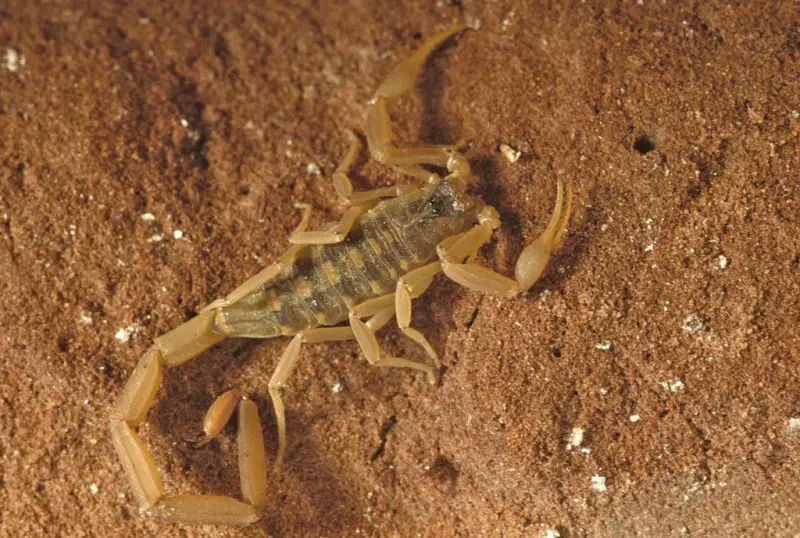When most people imagine scorpions, they think of scorching deserts in the American Southwest, not the wooded hills and rocky glades of Missouri. Yet the Show-Me State is home to its own population of scorpions. These arachnids live quietly in the shadows, often escaping notice until one crawls across a porch, emerges from a woodpile, or surprises someone in their basement.
The very idea of scorpions in Missouri tends to stir both fear and curiosity. Their pincers, segmented tails, and venomous stingers inspire images of dangerous predators, but the truth is far more complex and fascinating. Scorpions here are not only survivors of deep evolutionary history but also key players in controlling insect populations. To appreciate their presence, it is important to look beyond the myths and uncover the facts about how they live, what they look like, and why they matter.
Identification of Scorpions in Missouri
Recognizing the Striped Bark Scorpion

The striped bark scorpion, Centruroides vittatus, is the only true scorpion species naturally occurring in Missouri. It is a relatively small creature, usually ranging from one to two and a half inches in length. Its slender body and long tail give it an elegant yet intimidating appearance. Pale yellow to tan is the most common coloration, though some individuals lean toward a slightly darker golden hue. Running along the top of the abdomen are two prominent dark stripes, which are the easiest way to confirm identification.
On closer inspection, the scorpion has a dark triangular patch on its carapace just above the eyes, another distinctive feature. Its pincers are narrow and delicate compared to some other scorpions found in the desert Southwest, while its tail curves gracefully upward, ending in a sharp stinger. Though menacing in appearance, its sting is far less dangerous than that of its desert cousins.
Distinguishing Scorpions from Look-Alikes
Many people confuse pseudoscorpions with young scorpions. Pseudoscorpions are tiny arachnids that resemble scorpions but lack the long, curved tail and venomous stinger. Measuring just a few millimeters, they are often found inside homes or hidden in leaf litter. Their pincers allow them to capture and feed on mites, larvae, and other tiny creatures, making them useful pest controllers.
Unlike true scorpions, pseudoscorpions are completely harmless to humans. The key differences lie in their size and the absence of the iconic tail. Recognizing this distinction can prevent unnecessary fear when encountering these minuscule creatures indoors.
Understanding Color Variations
Although the striped bark scorpion has a general tan-and-striped pattern, variations do occur. Juveniles tend to be lighter in color, while older individuals may appear darker. Environmental conditions such as soil type and light exposure can subtly influence their shade. These differences sometimes cause locals to believe multiple species exist in Missouri, when in fact they are simply looking at variations of the same one.
Habitat of Scorpions in Missouri
Natural Habitats in the Ozarks
The heartland of Missouri scorpion populations lies in the southern Ozark region. The Ozarks provide the warm, rocky terrain that these arachnids need to thrive. Limestone glades, dry ridges, and hillsides dotted with cedar and oak trees create ideal conditions. These environments mimic the arid settings scorpions prefer, with plenty of crevices and stones under which to hide.
During the daytime, scorpions retreat into the cool shelter of rocks, bark, or rotting logs to escape the sun and predators. As night falls, they emerge to hunt across the rocky ground, using the cover of darkness as both camouflage and protection. This combination of sunlight for warmth and rocky cover for safety is what makes the Ozarks particularly favorable.
Adapting to Human Structures
Scorpions in Missouri are opportunistic and frequently extend their habitat into human spaces. Old barns, sheds, stone foundations, and piles of firewood are common refuges. In rural communities, it is not unusual to discover one beneath a pile of lumber or inside an old boot left outdoors overnight.
In recent years, urbanization has also played a role in altering scorpion behavior. As people build homes in or near the Ozarks, scorpions sometimes wander inside through cracks or open doors. Basements, attics, and cluttered storage areas become accidental shelters. While encounters inside the home can be unsettling, these scorpions are not aggressive and typically hide rather than confront humans.
Seasonal Distribution
Missouri scorpions are most active during the warm months from late spring through early autumn. In winter, the cold climate forces them to retreat into sheltered spaces where temperatures remain above freezing. They slow their metabolism and conserve energy, surviving until warmth returns. In some cases, they may even venture indoors seeking warmth, which explains occasional winter sightings in houses.
Behavior of Missouri Scorpions
Hunting and Feeding
The striped bark scorpion is a patient nocturnal hunter. As night falls, it leaves its hiding spot and begins searching for prey. Its diet includes crickets, beetles, spiders, and sometimes even other scorpions. The pincers are used to grab prey, while the stinger delivers venom that immobilizes the victim. Once subdued, the scorpion uses digestive enzymes to break down the prey’s tissues before consuming the liquid meal.
Hunting relies on a combination of sensory adaptations. Fine hairs on their legs detect vibrations in the soil, allowing them to sense footsteps of tiny creatures. Specialized comb-like organs on the underside, called pectines, pick up chemical cues and help the scorpion navigate its environment. Together, these adaptations make them efficient predators even in total darkness.
Nocturnal Activity and UV Glow
Scorpions are almost entirely nocturnal. This not only protects them from predators but also reduces water loss in hot conditions. In Missouri, nighttime activity means they are rarely seen unless deliberately searched for. Interestingly, scorpions glow under ultraviolet light, producing an eerie green or blue fluorescence. The purpose of this trait remains a mystery, though hypotheses include protection from sunlight and a form of communication. For nature enthusiasts, shining a UV flashlight at night is the best way to observe these creatures in their natural environment.
Social and Reproductive Behavior
Scorpions are solitary by nature, but they do come together to mate. The mating ritual is one of the most fascinating aspects of their behavior. The male and female engage in a sort of dance, locking pincers as the male leads the female to a location where he deposits a sperm packet. This ritual can last for hours, and once complete, the two separate.
Female scorpions give birth to live young, not eggs. The newborns climb onto their mother’s back immediately after birth, clinging to her until their first molt. During this time, the mother fiercely protects them, a surprising level of parental care for an animal often viewed as aggressive. Once the young molt and develop protective exoskeletons, they disperse to live independently.
Surprising Facts About Scorpions in Missouri
Survivors of Ancient Evolution
Scorpions are among the oldest known terrestrial animals, with ancestors that lived more than 400 million years ago. Fossil records show that early scorpions were aquatic before eventually adapting to life on land. The striped bark scorpion is part of this ancient lineage, a living reminder of survival across millennia. Their continued existence in Missouri highlights the adaptability that has allowed scorpions to thrive in environments far from deserts.
Myths and Misconceptions
Many myths surround scorpions in Missouri. One common belief is that their sting is deadly, when in truth it is rarely more harmful than a bee sting. Another misconception is that scorpions are aggressive and chase humans. In reality, they prefer to avoid confrontation and will only sting when threatened or accidentally stepped on.
There are also folk tales claiming that scorpions sting themselves to death when surrounded by fire. This is not true. What actually happens is that exposure to intense heat causes their nervous system to misfire, sometimes making the tail strike reflexively. The sting is not a deliberate act of suicide.
Cultural Significance
Scorpions have made their way into local stories and cultural references in Missouri. In some rural communities, finding a scorpion in the home is considered a sign of dry weather or a warning to be careful when handling firewood. For hikers and naturalists, spotting a scorpion glowing under black light has become a unique outdoor adventure.
Scorpions and Humans: Coexistence in Missouri
Safety Precautions
Living in scorpion territory requires simple precautions. Wearing gloves while handling rocks or wood reduces the risk of stings. Checking shoes, clothing, and bedding in areas known for scorpions can prevent unpleasant surprises. Indoors, sealing cracks, weatherstripping doors, and reducing clutter go a long way in keeping scorpions out.
If a sting occurs, most people experience sharp pain, redness, and mild swelling. Cleaning the site, applying a cold compress, and using pain relief are usually enough. For children, elderly individuals, or those with allergic reactions, seeking medical attention is the safest course of action. While fatalities are virtually unheard of in Missouri, caution is always wise.
Ecological Importance
Rather than viewing scorpions only as pests, it helps to understand their ecological benefits. By consuming insects such as cockroaches, crickets, and beetles, they help regulate populations that could otherwise grow out of control. This natural pest control reduces reliance on chemical insecticides. Their role in the food web also supports larger predators, including birds and mammals, which occasionally feed on scorpions.
Comparison with Scorpions in Other States
Scorpions in Missouri differ significantly from those in the deserts of Arizona, Texas, and New Mexico. While species like the Arizona bark scorpion can deliver medically significant stings, the striped bark scorpion’s venom is mild by comparison. Missouri scorpions are also smaller and more secretive, preferring rocky glades over wide-open desert sands.
Their northern distribution makes them unique, as scorpions are generally associated with warmer climates. Missouri represents one of the farthest eastern and northern ranges for scorpions in the United States. This distribution demonstrates their adaptability and raises interesting questions for biologists studying the effects of climate on scorpion survival.
Conclusion
Scorpions in Missouri are far more fascinating than frightening. The striped bark scorpion, with its distinctive stripes, glowing body under UV light, and ancient evolutionary lineage, is a resilient survivor perfectly adapted to the Ozark landscape. Although often misunderstood, these creatures are shy, nocturnal hunters that play a vital role in controlling insect populations.
By learning how to identify them, recognizing their preferred habitats, and understanding their surprising behaviors, Missouri residents can replace fear with respect. Rather than symbols of danger, scorpions are reminders of the complexity of the natural world and the hidden biodiversity that thrives even in unexpected places.
Missouri’s scorpions continue to spark curiosity and awe. Whether glimpsed beneath a stone, glowing under a black light, or spotted in the shadows of a warm summer night, they remind us that the state’s wildlife holds many secrets waiting to be discovered.
FAQs about Scorpions in Missouri
Are there scorpions in Missouri?
Yes, scorpions are found in Missouri, with the Striped Bark Scorpion being the most common species. They primarily inhabit the southern and central regions of the state, especially in rocky woodlands and areas with plenty of cover such as logs, stones, and leaf litter.
Are scorpions in Missouri dangerous to humans?
Scorpions in Missouri are not considered deadly to humans. Their sting is comparable to that of a bee or wasp, usually causing localized pain, redness, or swelling. Severe allergic reactions are rare, but individuals sensitive to insect venom should exercise caution and seek medical attention if stung.
Where are scorpions most commonly found in Missouri?
Scorpions in Missouri thrive in warm, dry, and rocky environments. They are frequently found in the Ozark region, hiding under rocks, bark, and leaf litter. Occasionally, they may wander into homes during hot summer months or periods of drought when searching for water or prey.
How can I identify a Missouri scorpion?
The Striped Bark Scorpion, Missouri’s primary species, is identifiable by its pale yellow to tan body with two distinct dark stripes running lengthwise along its back. Adults typically measure around 2 to 3 inches long. Their slender pincers and curved tail ending in a venomous stinger are also key identification traits.
Do Missouri scorpions enter homes?
Yes, scorpions can enter homes, especially in rural or wooded areas. They may seek shelter in basements, crawl spaces, or near sources of moisture. Homeowners can reduce encounters by sealing cracks, reducing clutter, and removing woodpiles or debris close to the house.
What do scorpions in Missouri eat?
Missouri scorpions are nocturnal hunters, feeding primarily on insects and small arthropods such as crickets, beetles, and spiders. They use their pincers to grasp prey and their venomous sting to subdue it before consuming it.
Can scorpions survive Missouri winters?
Yes, scorpions in Missouri are adapted to seasonal changes. During cold winters, they enter a state of dormancy, often hiding beneath rocks, logs, or inside crevices to avoid freezing temperatures. This allows them to survive until warm weather returns.
How do I prevent scorpions around my property?
Prevention includes reducing hiding places such as woodpiles, rocks, and leaf litter near homes. Sealing entry points like gaps under doors or cracks in walls can also help keep scorpions out. Maintaining a clean yard and controlling insect populations reduces their food sources.
Are scorpions protected in Missouri?
No, scorpions in Missouri are not considered endangered or legally protected. They play a beneficial role in the ecosystem by controlling insect populations, but they are not regulated species in the state.
What should I do if I get stung by a scorpion in Missouri?
If stung by a scorpion, wash the area with soap and water, apply a cold compress to reduce swelling, and monitor symptoms. Most stings are mild and subside within a few hours. However, if symptoms worsen, such as difficulty breathing, severe swelling, or an allergic reaction, seek medical attention immediately.






